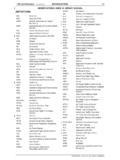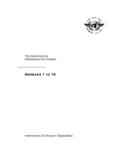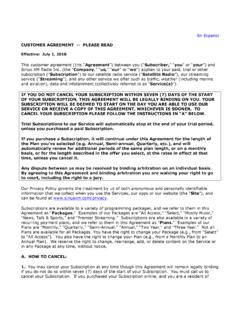Transcription of dorenda.baker@faa - arsa.org
1 May 7, 2018 By email Delivery and read receipts requested to: Dorenda Baker Executive Director, Aircraft Certification Service Federal aviation Administration 800 Independence Avenue, SW Suite 800 East Washington, DC 20591-0001 John S. Duncan Executive Director, Flight Standards Service Federal aviation Administration 800 Independence Avenue, SW Room 831 Washington DC 20591-0001 RE: Guidance for Using Remote Connectivity Technology and Tools Dear Ms. Baker and Mr. Duncan: The undersigned industry representatives submit the attached draft Advisory Circular (AC), Guidance for Using Remote Connectivity Technology and Tools for consideration. Technologies such as satellite or internet, which provide reliable connectivity through video, live-stream and other visual and audio delivery methods have become ubiquitous. However, using available technology for certification and compliance-related activities traditionally accomplished in-person-on-premises requires updated FAA guidance to delineate acceptable practices.
2 After coordination with agency personnel and review of the pending Policy Statement, Remote Witnessing Using Video, this draft AC was developed for submission. Considering the FAA s own use of remote technologies for both internal and external oversight as well as congressional direction to encourage innovation, adoption of the AC would provide the baseline for compliance with 14 CFR by the agency, its applicants and certificate holders. We urge adoption of the attachment in lieu of the pending policy; we believe basic guidance for all applications of this technology is required. We appreciate your assistance with this issue and look forward to your timely response. Sincerely, Sarah MacLeod Executive Director Aeronautical Repair Station Association 121 North Henry Street Alexandria, VA 22314-2905 ext. 114 David Silver Vice President, Civil aviation Aerospace Industries Association 1000 Wilson Boulevard Suite 1700 Arlington, VA 22209-3928 May 7, 2018 Ms.
3 Dorenda Baker and Mr. John S. Duncan Page 2 RE: Guidance for Using Remote Connectivity Technology and Tools David Oord Senior Director, Regulatory Affairs Aircraft Owners and Pilots Association 50 F Street, NW Suite 750 Washington, DC 20001-1578 Robert Ireland Managing Director, Engineering & Maintenance Airlines for America 1275 Pennsylvania Avenue, NW Suite 1300 Washington, DC 20004-2450 Michele Dickstein President aviation Suppliers Association 2233 Wisconsin Avenue, NW Suite 503 Washington, DC 20007-4104 Crystal Maguire Executive Director aviation Technician Education Council Post Office Box 234 Jenks, OK 74037-0234 Yvette Rose Senior Vice President Cargo Airline Association 1620 L Street, NW Suite 610 Washington, 20036-5605 Joe Sambiase Director, Maintenance & Airworthiness General aviation Manufacturers Association 1400 K Street.
4 NW Suite 801 Washington, DC 20005-2402 Jason Dickstein President Modification and Replacement Parts Association 2233 Wisconsin Avenue, NW Suite 503 Washington, DC 20007-4104 George Paul Vice President, Technical Services National Air Carrier Association 1000 Wilson Boulevard Suite 1700 Arlington, VA 22209-3928 May 7, 2018 Ms. Dorenda Baker and Mr. John S. Duncan Page 3 RE: Guidance for Using Remote Connectivity Technology and Tools John McGraw Director of Regulatory Affairs National Air Transportation Association 818 Connecticut Avenue, NW Suite 900 Washington, DC 20006-2733 Stacey Bechdolt Vice President, Safety & Operations and Regulatory Counsel Regional Airline Association 1201 15th Street, NW Suite 430 Washington, DC 20005 Paul D. Wolf Superintendent Regulatory & Quality System Oversight The Boeing Company, Commercial Airplanes Box 3707 MC 67-XC Seattle, WA 98124-2207 Ronald J.
5 Witkowski Director of Quality, Regulatory Compliance Gulfstream Aerospace Corporation 500 Gulfstream Road Savannah, GA 31408-9643 Paul Hawthorne Director, Global Support Quality MOOG Aircraft Group Seneca & Jamison Roads East Aurora, NY 14052-0018 John Goglia Chairman Professional aviation Maintenance Association Post Office Box 1245 Sangus, MA 01906-1245 cc: Ali Bahrami Michael Romanowski Susan McCormick Robert Anoll Chinh Vuong Attachment: Draft Advisory Circular Guidance for using Remote Connectivity Technology and Tools 1 Department of Transportation Federal aviation Administration Advisory Circular Subject: Guidance for Using Remote Connectivity Technology and Tools Date: Initiated by: AC No: Change: 1. What is the purpose of the Advisory Circular (AC)? This AC describes the regulations and procedures that enable a task or activit y to be accomplished remotely using connectivity technologies, tools and equipment such as internet or satellite connections, video and live streaming.
6 This AC includes, but is not limited to, oversight, inspections and tests used to establish, validate or oversee compliance with 14 CFR. Like all advisory material, this AC is not in itself mandatory and does not constitute a regulation. It provides a means, but not the only means to comply with regulatory requirements. When this AC uses mandatory language ( , must or may not ) it is quoting or paraphrasing a regulatory requirement or prohibition. When this AC uses permissive language ( , should or may ), it describes an acceptable means. Instead of following this method, you may elect an alternate, provided your method is acceptable to the FAA. Because the method of compliance that is presented in this AC is not mandatory, the term should applies only if you choose to follow this particular method.
7 2. To whom does this AC apply? The FAA has concluded that remote technology is a viable option for the agency, applicants and certificate holders to achieve oversight, inspections, tests or training activities or tasks under 14 CFR. Remote connectivity and associated tools and equipment used to accomplish and/or validate tasks, inspections and tests and to provide oversight and training have expanded since the regulations were originally adopted. The agency is using some of these technologies, tools and equipment to accomplish training as well as to perform oversight tasks and communications. It recognizes the validity of technological advancements that provide levels of assurance equivalent to or better than on-premise or in-person observation or performance. The agency acknowledges the capability of new technology in its rulemaking activities, for example, the Part 23 Aviat ion Rulemaking Committee (ARC) recommended the FAA develop policy regarding remote tests observation and validation.
8 The agency provides remote training for its workforce and allows certificate holders to accomplished required tasks by live-streaming or video. Furthermore, Congress has passed laws that direct executive agencies to allow and encourage the use and recognition of innovative and new technology. 2 These technologies enable the agency and the industry to: 1) be more cost effective ( , reducing travel costs); 2) improve timeliness; and 3) reduce oversight burdens. Generally, use of remote technology to accomplish oversight, design, production, operation or maintenance tasks and activities is acceptable for establishing or showing compliance. Specifically, tasks and activities traditionally accomplished in-person-on-premise may be conducted through technologies such as satellite or internet connectivity, video, live-stream or other devices provided the same level of assurance or safety is attained.
9 3. What are the related 14 CFR parts? Any section of 14 CFR that requires oversight, testing, inspection or supervision. Any section of 14 CFR that prohibits the falsification of applications, reports or records used to show compliance. Examples include but are not limited to: Section Falsification of applications, reports, or records. Section Inspection and tests. Section (e)-(g) Qualit y system. Section Inspections and tests. Section Inspections and tests. Section Persons authorized to perform maintenance, preventive maintenance, rebuilding, and alterations. Section Approval for return to service after maintenance, preventive maintenance, rebuilding, or alteration. Section Persons authorized to approve aircraft, airframes, aircraft engines, propellers, appliances, or component parts for return to service after maintenance, preventive maintenance, rebuilding, or alteration.
10 Section Content, form, and disposition of maintenance, preventive maintenance, rebuilding, and alteration records (except inspections performed in accordance with part 91, part 125, (a)(1), and of this chapter). Section Maintenance records: Falsification, reproduction, or alteration. Applicable sections in parts 61, 65, 91, 121, 125, 129, 135, 145, 147 including any policies, procedures for conducting oversight and inspection tasks associated with inspecting or auditing, quality assurance requirements, recordkeeping and the falsification, reproduction or alteration of records required by each part. 4. What additional guidance material is available? Any advisory circulars, orders, policies or notices that involve oversight, inspection, testing or supervision. 5. What are the general requirements for using remote connectivity?









